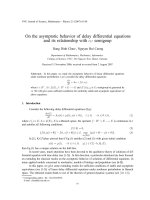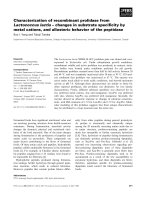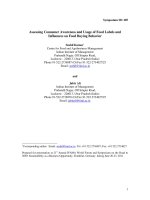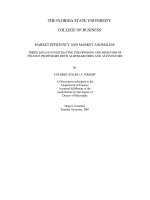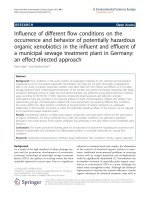Organic food purchasing behavior of young consumers: The role of environmental concern
Bạn đang xem bản rút gọn của tài liệu. Xem và tải ngay bản đầy đủ của tài liệu tại đây (622.72 KB, 11 trang )
Hue University Journal of Science
ISSN 2588–1205
Vol. 126, No. 5B, 2017, pp. 59–71
ORGANIC FOOD PURCHASING BEHAVIOR OF YOUNG
CONSUMERS: THE ROLE OF ENVIRONMENTAL CONCERN
Nguyen Thi Hang Nga*
Banking University HCM City, 36 Ton That Dam Street, District 1, Ho Chi Minh City, Viet Nam
Abstract: This study focuses on the factors that can affect purchasing behaviour of young customers
regarding organic food. The results show that attitudes, perceived behavioral control, perceived consumer
effectiveness (PCE) and concern for self-image positively impact the purchasing behaviour of highlyenvironmental concerned consumers. Those who do not concern environment do not care about these
qualities. Subjective norms positively affect consumers’ behaviour. However, the effect of subjective norms
on the purchasing behaviour of low-environmental concerned consumers is greater than that of consumers
with high environmental concern.
Keywords: Consumer behaviour, organic food, PCE, environmental concern, concern for self-image
1
Introduction
At present, the sustainable consumption trend is concerned by not only developed countries but
also developing countries. The consumption of goods and services that are of a high quality for
life and do not pollute the environment nor affect the needs of future generations is considered
as sustainable consumption. Green consumption is an integral part of sustainable consumption.
Currently, the environmental quality issue tends to be severe due to global warming, air
pollution and disasters such as tsunamis, floods, and droughts. Therefore, people including
customers pay much more attention to environmental protection issues. When consumers,
especially the young ones, are aware of their own responsibilities for the environmental
protection related to consuming goods and products, they are willing to buy the proenvironment products (Chen, 2010).
Young people are highly educated, and they are aware of their responsibilities for the
environment. Therefore, the green consuming behavior of young people is the subject of recent
studies (Chen & Bottle, 2010; Kim, 2011; Lee, 2008; Lee. 2009). In Vietnam, sustainable
consumption, in general, and green consumption, in particular, has not been much cared of. It is
still a new study field. Vietnam has a population of over 90 million people with about 40 %
young people aged 10 to 24. This means that Vietnam is a potential market for green or proenvironment products. The green growth trend of the economy has also been cared about by
the Government in recent times. Therefore, enterprises’ philosophy of green and sustainable
production becomes necessary, and the green marketing strategy plays an important role at this
* Corresponding:
Submitted: August 25, 2016; Revised: September 15, 2016; Accepted: March 20, 2017.
Nguyen Thi Hang Nga
Vol. 126, No. 5B, 2017
time. It makes consumers better aware of the environmental issues and creates a competitive
advantage in enterprises’ green philosophy.
According to Lee (2009), green products are the products that are favorable for the
environment and the behavior of buying products that are favorable for and friendly with the
environment is referred to as green buying behavior. Schlegelmilch et al. (1996) divided green
products into categories such as recyclable products, products that are not tested on animals,
fruits and vegetables grown by organic methods, products that are not harmful to ozone and
energy products. Vu Anh Dung et al. (2012) said that green products can be divided into
categories such as organic food, household electrical appliances, means of travel, garment,
stationeries, and other products. Thus, the consumption of organic food is one aspect of the
green consumption. Some studies of reviewing the behavior of the organic food consumption
are conducted in a number of different countries such as Chen (2007), Dean et al. (2008). In
Vietnam, some studies have been conducted to review green consumption behavior as Pham
Thi Lan Huong (2014), Vu Anh Dung et al. (2012). However, these studies only referred to the
green consumption behavior in general without considering the consumption behavior in a
specific field such as organic food, and they only review a certain aspect of the interpretation of
green consumption behavior; thereby the generalizing level is not high. This study was
performed to review the factors affecting young consumers’ intention of buying organic food.
Specifically, it reviewed the role of the factor pertaining to the environment in the interpretation
of the organic food consumption intention.
2
Review of the literature
Theory of planned behavior (TPB) of Ajzen (1991) is widely used in various study fields such as
advertising, health care, food choices including organic foods as the study of Chen (2007), Dean
et al. (2008), Gracia & Magistris (2007), Saba & Messina (2003), and Thogersen (2007). According
to TPB, intention (I) was explained by factors such as attitude toward behavior (A), subjective
norms (S) and perceived behavioral control (PBC). An attitude towards behavior is a positive or
negative assessment level when behaviors are performed (Ajzen & Fishbein, 1980). Ajzen &
Fishbein (2005) showed that the attitude is an important predication factor of behavioral
intentions. The results are also confirmed in many different studies. The studies in the field of
organic food done by Chen (2007), Dean et al. (2008), Saba & Messina (2003), and Thogersen
(2007) also showed that the attitude towards behavior has a positive relationship with
consumers’ intention of buying organic food. Gracia & Magistris (2007) said that there is a
positive relationship between the attitude and the intention of buying organic food-related
aspects of health and environmental benefits.
A subjective norm is a social pressure from the perception of whether or not to perform
the behavior (Ajzen, 1991). The pressure from society includes the one from family, friends,
62
Jos.hueuni.edu.vn
Vol. 126, No. 5B, 2017
media, schools and other surrounding objects. For young people, the social pressure is one of
the strongest factors that explain behavioral intentions, especially the pressure from friends
(Bindah & Othman, 2012). In the organic food sector, Vermeer & Verbeke (2006) said that the
pressure of surrounding people might explain a strong intention of buying sustainable dairy
products whether that person has a low attitude. Chen (2007) showed a positive relationship
between subjective norms with the intention of buying organic food. The study done by Gotschi
et al. (2007) showed that standards and learning values in family positively influence the
attitude development in terms of consuming organic food, while school environment will less
impact the attitude formation. It is thought that people often follow subjective norms because
not only are they afraid of the pressure from surrounding people but also get information the
behavior of which is most appropriate and beneficial (Bamberg et al., 2007).
The perceived behavioral control is the ease or difficulty that a person is aware of the
performance of a particular behavior. In other words, PBC is related to personal feelings of the
ability to perform a certain behavior (Ajzen, 1991). Dean et al. (2008) indicated a positive
relationship between PBC and the consumers’ intention of buying organic apples. Similarly,
Thogersen (2007) also reported that the role of PBC in explaining the intention of buying fresh
tomatoes and organic tomato sauce.
In addition to variables in the TPB model, the studies in the field of green consumption
also refer to the factors related to the ecological environment, such as the factor of perceived
consumer effectiveness (PCE), environmental concerns (EC), and concern for self-image (CI).
According to Taylor & Ahmed (1974), PCE is understood as consumers’ confidence that they
can contribute effectively in solving environmental issues. Many studies have used PCE to
explain the intention of buying green products, and the results showed that the consumers who
have high PCE will have positive behavior on the environment (Lee, 2008; Vermeir & Verbeke,
2007). Environmental concerns express anxiety, passion, and attention to environmental
consequences. Lee (2008), Kim & Choi (2005) showed that the factor of environmental concerns
positively affected green consumption intentions of consumers. The concern for self-image is
said to be all the ideas, thoughts and feelings that individuals themselves have compared with
others in a particular context. The concern for the self-image of consumers is reflected through
their consumption of goods. In other words, the goods used by consumers will increase concern
for self-image, highlight individual’s images, which is especially important for young
consumers. Lee (2008) reported that CI strongly impacts young consumers’ green consumption
intentions.
Basing on TPB theory and some study results in the field of organic food, this study
reviewed the impact of the components of TPB on the intention of buying organic food and also
included PCE, CI components into the model to consider their impact rate in accordance with
63
Nguyen Thi Hang Nga
Vol. 126, No. 5B, 2017
the change of the environmental concern factor. Therefore, the study model is proposed as
shown in Figure 1.
EC
A
S
I
PBC
PCE
CI
Figure 1. The conceptual model
3
Research methodology
This study used a quantitative research method based on a convenient sample of 458 young
consumers in Ho Chi Minh city. The study was carried out by surveying with a questionnaire
based on a 5-level Likert scale: strong disagreement is at level 1 and strong agreement is at level
5. The scale and questions in the study were based on the previous studies in the field of green
consumption (Linh, 1997; Lee, 2008; Taylor & Todd, 1995; Vermeir & Verbeke, 2007). The
attitude scale (A) consists of 3 questions related to support the idea of organic food
consumption and general attitudes with organic food consumption. The subjective norms scale
(S) consists of 3 questions related to the pressures of family, friends, and environmental
organizations to the organic food consumption. The perceived behavior control scale (PBC)
with 4 questions related to the easy or difficult control when consuming organic food. The
perceived consumer effectiveness scale (PCE) consists of 2 questions related to the effective
personal contribution to the environment. The environmental concern scale (EC) including 4
questions expressing consumers’ anxiety, passion, and attention to environmental issues. The
concern for the self-image scale (CI) consists of 3 questions reflecting their outstanding image
when engaging in the environmental protection and the scale of the intention of buying consists
64
Jos.hueuni.edu.vn
Vol. 126, No. 5B, 2017
of 3 questions expressing the intention of buying organic food in the coming time. After
collecting and selecting, the data were analyzed by using the SPSS 16.0 software to make the
statistical and descriptive analysis, correlative analysis, reliability test of scale with Cronbach’s
alpha tool, and exploratory factor analysis. Then, the clustering analysis according to EC factor
was made, and the clustering analysis results were used to make regression analysis.
4
Results and discussion
4.1
Descriptive statistics
The results of the statistical and descriptive analysis showed that males accounted for 21.2 %
and females for 78.8 % in the study sample. The average value of PCE and EC variables is equal
to 4.2587 and 4.0611, respectively – the highest among the variables (Table 1). This shows that
young consumers are most interested in environmental issues as well as the belief that their
actions can contribute effectively to solving environmental issues. The average value of CI
variable is, however, equal to 3.1994 – the lowest compared with that of the others. It can be
seen that the assessment level of concern for the self-image in the environmental protection has
not greatly been appreciated by the youth. Maybe, young consumers are interested in the
environment and believe that their actions will contribute positively to the environment, but
they do not concern their self-image. This is relatively consistent with the characteristics of
Vietnam where environmental issues have not been properly aware of, concerned nor highly
appreciated by society.
Table 1. Descriptive statistics of the variables
4.2
Variables
N
Mean
Std. Dev.
PCE
458
4.2587
0.7434
EC
458
4.0611
0.5672
A
458
3.8923
0.7973
I
458
3.5596
0.6415
S
458
3.5247
0.7811
PBC
458
3.2309
0.6857
CI
458
3.1994
0.8472
Cronbach’s alpha and EFA analysis
To assess the reliability of the scales, the study tested the Cronbach’s alpha. The test result of the
scales meets the reliability requirements, and the coefficient of Cronbach’s alpha is between
0.628 and 0.899 (Table 2). The correlation coefficient of the variable sum is greater than 0.3.
After the scales were checked for reliability, the analysis of exploratory factor was
performed using the Promax rotation. The procedure enabled to extract 6 factors including A, P,
65
Nguyen Thi Hang Nga
Vol. 126, No. 5B, 2017
S, PEC, CI, PCE with the variance equal to 67.265 %; KMO coefficient of Bartlett is equal to 0.8
with a sig. = 0.000, and the minimal load coefficient of the factor is 0.442.
Table 2. Cronbach' alpha of variables
4.3
Variables
Cronbach’s alpha
PCE
0.693
EC
0.701
A
0.899
I
0.712
S
0.840
PBC
0.742
CI
0.628
Correlation analysis, cluster analysis, and regression
The correlation analysis result showed that the independent variables are correlated with the
dependent variable at the 5 % significance level. The impact of the independent variables on the
dependent variable was assessed. Firstly, the study used the method of ordinary least squares
(OLS) through original TPB model. The results showed that the attitudes, subjective norms, and
perceived behavioral control positively affect the intention of buying organic food at 5 %
significance. The model explains about 20.5 % of the variation of the dependent variable. As
discussed above, the study continued to perform the expanded regression model by adding the
variables related to the environment such as PCE and CI. The results are shown in Table 3.
Table 3. Regression analysis
Variables
p-value
VIF
A
0.144
0.001
1.668
S
0.178
0.000
1.787
PBC
0.098
0.019
1.151
PCE
0.093
0.016
1.161
CI
0.068
0.039
1.086
constant
1.445
0.000
R =22.5 %
Durbin-watson = 2.008
Sig. = 0.000
2
The expanded model showed that all the independent variables positively affect the
dependent variable at the 5 % significance level. The model explanation level gained 22.5 %. In
both models, the attitude and subjective norms remain the two most powerful explaining
factors of young consumers’ intention of organic food consumption; the perceived consumer
66
Jos.hueuni.edu.vn
Vol. 126, No. 5B, 2017
effectiveness and concern for the self-image explain the intention of organic food consumption
at a lower level than the remaining variables.
To assess the role of the environmental concern in explaining the impact of the
independent variables on the dependent variable, the study conducted the clustering analysis
for this factor. The EC variable is included to analyze the clusters by K-means with 2 set of
clusters. The analysis results of the EC component cluster with a sig. = 0.000 showed that the
clustering is appropriate, and the EC component result was classified into 2 clusters: high level
of environment concerns (ECH) and low level of environment concerns (ECL) with average
value of 4.26 and 3.18, respectively. After conducting cluster analysis, the variables were put
into the regression using the OLS method. The regression results clusters analysis are shown in
Table 4.
Table 4. Regression analysis clusters ECH and ECL
Variables
Clusters ECL
Clusters ECH
Beta
p-value
Beta
p-value
A
0.020
0.826
0.197
0.000
S
0.363
0.000
0.163
0.001
PBC
0.011
0.913
0.090
0.049
PCE
0.053
0.598
0.104
0.012
CI
0.119
0.242
0.070
0.040
R2 = 21 %
Sig. = 0.002
Durbin-watson = 2.008
R2 = 26.4 %
Sig. = 0.000
Durbin-watson = 2.039
It is obvious that when a person has high attitudes towards behavior, perceived
behavioral control, perceived consumer effectiveness, and concern for self-image, their intention
of buying organic foods is higher. However, this was only true when they had the high level of
environmental concerns. For those who had the low level of environmental concerns, although
their attitudes, perceived behavioral control, perceived consumer effectiveness and concern for
self-image are high, they do not intend to perform the behavior. Only the subjective norms
affect the intention of buying with the statistical significance in both clusters. This means that
whether young consumers with the high or low level of environmental concerns, the pressure
of surrounding people as family, friends, and environmental organizations still significantly
influences their intention of buying organic products.
According to Ajzen & Fishbein (2005), the attitude was the most important prediction
factor for the behavioral intention. However, this study showed that the subjective norms were
the only factor which affects the consumption behavior of organic food the most with the group
of the low level of environmental concerns. Based on these results, it might be suggested that
organic food was still quite a new product for consumers, and the environmental issues had not
67
Nguyen Thi Hang Nga
Vol. 126, No. 5B, 2017
been cared by consumers in a developing country like Vietnam. Therefore, the pressure of
surrounding people becomes more important for consumers to buy products. However, for the
group of consumers with the high level of environmental concerns, the attitude was the
strongest explanation factor for their consuming intention.
Basing on the theoretical background of the planned behavior theory, Ajzen (1991)
reviewed the factors affecting young consumers’ consuming intention of organic food and the
potential consumers in the future. Organic food is a kind of green product, thus it is necessary
to expand the TPB model by merging factors such as perceived consumer effectiveness,
environmental concerns, and concern for the self-image. The results of this study indicated that
young consumers appreciate the perceived consumer effectiveness and the environmental
concerns with an average rating at 4.2587 and 4.0611, respectively. This is appropriate in terms
of the awareness of young people with the higher education level. However, the concern for the
self-image rating was at a relatively low level and the average rate was 3.1994. This indicates
that the environmental protection activities of young people to express concern for self-image is
not really important.
The attitude, perceived behavioral control, perceived consumer effectiveness, and
concern for the self-image positively affect the consumers’ intention for the group of people
with the high level of environmental concerns. However, for the group of people with the low
level of environmental concerns, the attitudes, perceived behavioral control, perceived
consumer effectiveness and concern for the self-image do not influence the intention of buying.
The subjective norms component positively affects the behavior intention regardless the level of
environmental concerns. This suggests that young consumers are subjected to pressure or
influenced by their surrounding people such as families, friends, environmental organizations
no matter their level of environmental concerns is high or low. However, the impact of the
subjective norms on the intention of buying of the group of consumers with the low level of
environmental concerns is higher than that of the group of consumers with the high level of
environmental concerns.
5
Conclusion
The results of this study showed that in addition to the factors in TPB model, those related to
the environment such as perceived consumer effectiveness, concern for self-image, and
environmental concerns significantly contributed to the explanation of young consumers’
intention of buying organic food in Vietnam. However, the contribution of such variables had
not been prominent compared with that of the original variables in the theory of planned
behavior model. The study also found that, in a country where environmental issues have not
been emphasized and appreciated, the subjective norms factor significantly contributes to the
explanation of the consuming intention of buying organic food. The consuming intention to
68
Jos.hueuni.edu.vn
Vol. 126, No. 5B, 2017
organic food can be influenced by many factors, but this study only referred to the factors
related to the environment, so further studies should expand to other factors related to health
problems to increase the explanation level to the model.
References
1.
Ajzen, I. (1991), The theory of planned behavior. Organizational Behavior and Human
Decision Processes, 50(2), 179-211.
2.
Ajzen, I. and Fishbein, M. (2005), “The influence of attitudes on behaviour”, in The Handbook of
Attitudes, Albarracin, D., Johnson, B. T. and Zanna, M. P. (Eds), Mahwah, NJ: Erlbaum.
3.
Ajzen, I. and Fishbein, M. (1980), Understanding attitudes and predicting social behaviour.
Englewood Cliffs, NJ: Prentice-Hall.
4.
Bamberg, S., Hunecke, M. and Blobaum, A. (2007), Social context, personal norms and the
use of public transportation: two field studies, Journal of Environmental Psychology, 27(3),
190–203.
5.
Bindah, E. V. and Othman, M. N. (2012), The effect of peer communication influence on the
development of materialistic values among young urban adult consumers. International
Business Research, 5(3), 2.
6.
Chen, M. F. (2007), Consumer attitudes and purchase intentions in relation to organic foods
in Taiwan: Moderating effects of food-related personality traits. Food Quality and
Preference, 18(7), 1008–1021.
7.
Chen, T. B. and Chai, L. T. (2010), Attitude towards the environment and green products:
Consumers’ perspective. Management science and engineering, 4(2), 27–39.
8.
Chen, Y. S. (2010), The drivers of green brand equity: green brand image, green
satisfaction, and green trust. Journal of Business Ethics, 93(2), 307–319.
9.
Dean, M., Raats, M. M. and Shepherd, R. (2008), Moral concerns and consumer choice of
fresh and processed organic Foods1. Journal of Applied Social Psychology, 38(8), 2088–2107.
10. Gotschi, E., Vogel, S. and Lindenthal, T. (2007), High school students' attitudes and behaviour
towards organic products: survey results from Vienna. Institute for Sustainable Economic
Development, DoE aSS, University of Natural Resources and Applied Life Sciences,
Vienna.
69
Nguyen Thi Hang Nga
Vol. 126, No. 5B, 2017
11. Gracia, A. and de Magistris, T. (2007), Organic food product purchase behaviour: a pilot
study for urban consumers in the South of Italy. Spanish Journal of Agricultural Research,
5(4), 439–51.
12. Kim, Y. (2011), Understanding green purchase: The influence of collectivism, personal
values and environmental attitudes, and the moderating effect of perceived consumer
effectiveness. Seoul Journal of Business, 17(1), 65–92.
13. Kim, Y. and Choi, S. M. (2005), Antecedents of green purchase behavior: An examination of
collectivism, environmental concern, and PCE. Advances in Consumer Research, 32, 592.
14. Lee, K., (2009), Gender Differences in Hong Kong Adolescent Consumers' Green
Purchasing Behavior. Journal of Consumer Marketing, 26(2), 87–96.
15. Lee, K. (2008), Opportunities for Green MarkeUng, Young Consumers. Marketing
Intelligence & Planning,26 (6), 573–586.
16. Ling-Yee, L. (1997), Effect of collectivist orientation and ecological attitude on actual
environmental commitment: the moderating role of consumer demographics and product
involvement. Journal of International Consumer Marketing, 9(4), 31–53.
17. Pham Thi Lan Huong (2014), Predicting green purchasing behavior intention among
young consumers: Effect of cultural and psychological factors. Journal of Economics &
Development , 200, 66–78.
18. Saba, A. and Messina, F. (2003), Attitudes towards organic foods and risk/benefit
perception associated with pesticides. Food quality and preference,14(8), 637–645.
19. Schlegelmilch, B. B., Bohlen, G. M. and Diamantopoulos, A. (1996), The link between green
purchasing decisions and measures of environmental consciousness. European Journal of
Marketing, 30(5), 35–55.
20. Taylor, J. R. and Ahmed, S. A. (1974), Ecologically concerned consumers: who are
they?. The Journal of Marketing, 20–24.
21. Taylor, S. and Todd, P. (1995), Understanding household garbage reduction behavior: a
test of an integrated model. Journal of Public Policy & Marketing, 192–204.
22. Thøgersen, J. (2007), Consumer decision making with regard to organic food products, in Vaz,
M.T.D.N., Vaz, P., Nijkamp, P. and Rastoin, J.L. (Eds), Traditional Food Production Facing
Sustainability: A European Challenge, Ashgate, Farnham.
23. Vermeir, I. and Verbeke, W. (2006), Sustainable food consumption: Exploring the consumer
“attitude–behavioral intention gap”. Journal of Agricultural and Environmental Ethics, 19(2),
169–194.
70
Jos.hueuni.edu.vn
Vol. 126, No. 5B, 2017
24. Vermeir, I. and Verbeke, W. (2007), Sustainable food consumption among young adults in
Belgium: Theory of planned behaviour and the role of confidence and values. Ecological
Economics, 64(3), 542–553.
25. Vu Anh Dung, Nguyen Thu Hien, Nguyen Thi Ngoc Anh (2012), Cognitive assessment
and green consumer behavior: The case of Hanoi consumer. Journal of Economics &
Development, 184, 46–55.
71


